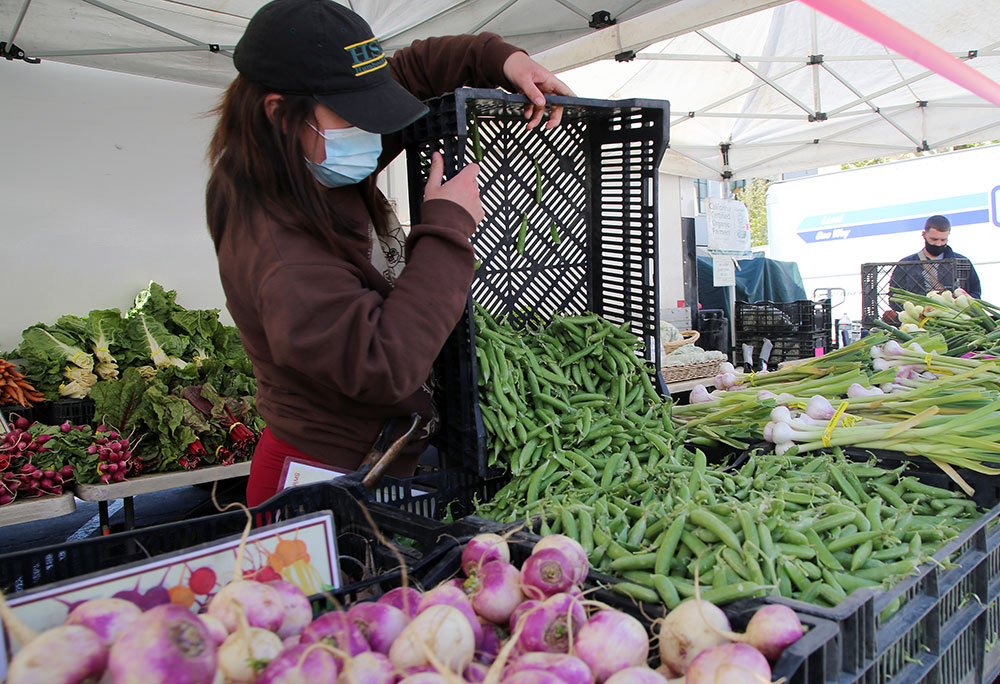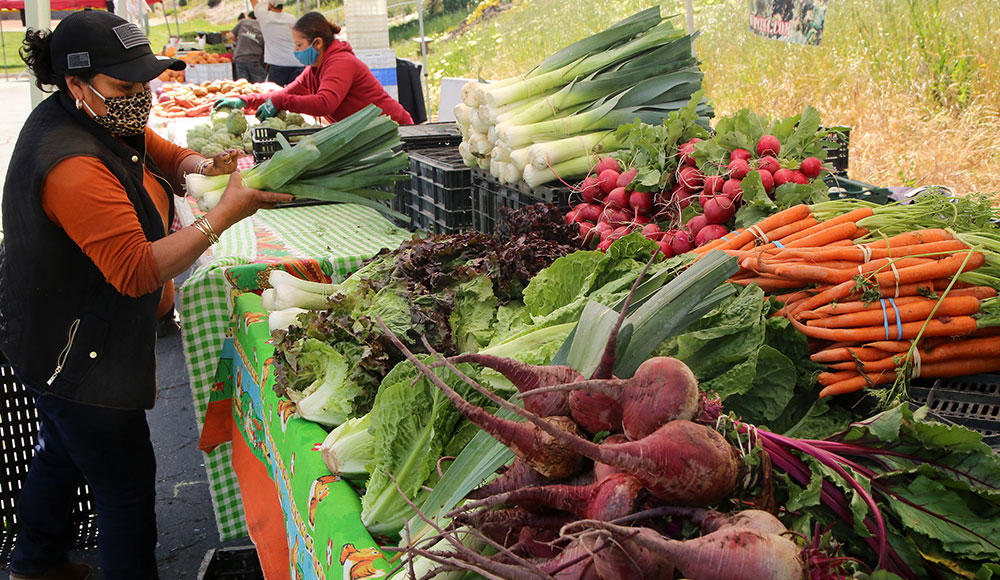This article was produced by Capital & Main. It is published here with permission.
On Friday, Jan. 10, four men worked quickly in a cold storage facility in Downtown Los Angeles, loading a van with vegetables.
The normally chatty crew were nearly silent as they transferred potatoes, carrots, beets, radishes, cabbage, greens and other produce that they had just trucked in from the fields near Bakersfield. The rest of the ordinarily bustling facility, with 20-some loading docks, was empty.
The owner of the farm, one of the best-known stars of the L.A. restaurant and farmers market scene, had revealed in an earlier phone call that agents from U.S. Border Patrol had been to the gates of their farm the day before, and many other farms in Bakersfield, looking to detain undocumented workers—including these men. The farmer asked we not use the name of the farm or any of their longtime workers, because they feared being targeted in an immigration raid.
The foreman of the crew working in the warehouse, who is a U.S. citizen, acknowledged he’d been on the farm when the agents showed up.
“Yes, Border Patrol came. I was out there. They didn’t pick up any of our people,” he said. The foreman asked not to be named to protect the identity of his employer.
“They came with a lot of trucks?”
“Yeah. Our guys were hiding in the packing shed until they left.”
On the phone, the farmer was livid.
“The impact this is going to have on food is crazy,” the farmer added. “They are visiting everyone. Southern California’s whole food infrastructure.” U.S Customs and Border Protection, the agency which includes Border Patrol, acknowledged in a statement that they had sent 60 agents from the El Centro office, more than 300 miles to the south on the Mexico border, to sweep the Bakersfield area for four days as part of “Operation Return to Sender.” The agency reported arresting 78 persons, but others estimated that nearly 1,000 may have been arrested and released.
The farmer said there are normally 15-18 people in the fields, but that on Jan. 10 only five showed up. California grows a quarter of all the country’s fresh produce, fruits and nuts—most of which require hand labor to process, as opposed to automation. It’s harvest time for seasonal oranges, mandarins, lemons and other citrus right now.
“Trump doesn’t want so-called ‘terrorists’ to come in from other countries, but he won’t let our people pick the food we all eat. Where does he think the food is going to come from?” the farmer added.
The new administration, it seems, should be asking the same question. Rather than seeking to get rid of migrants, the government is likely in the long run to be looking for more of them. “California and the United States face a big challenge in the demography of our country and state: For the first time in our history, we have more people retiring than entering the labor force,” said Hans Johnson, a demographer with the Public Policy Institute of California.
Baby boomers are exiting the labor pool, and younger cohorts that we have given names like Millennials or Gen Z just aren’t as numerous. The lack of young people in schools across the country from elementary through college has already caused consolidations and closures, a phenomenon Johnson also studies. PPIC reports that California relies on inflows of workers from other states and also immigration to drive its booming economy.
“So in California, we are home to more immigrants than any other state, and we have a higher share of our population made up of immigrants than any other state,” continued Johnson. “Immigrants in California, including those who are here either as naturalized citizens or those who have legal permanent status, and those who have unauthorized and temporary status, make up almost one out of every three workers in the state.”
There are an estimated 500,000 to 800,000 farmworkers in California—one-third to one-half of all the farmworkers in the U.S. The office of Gov. Gavin Newsom estimates that 50% of those in California are unauthorized; other estimates are higher. If a significant number of those workers are deported, or even just too scared to work, Johnson said, labor shortages would be serious. Farmers would lose money or go out of business. Tax revenues would fall. Food production would go down. A cascade of supply chain issues would drive up food prices.


In fact, this has already happened in recent history: In 2011, both Georgia and Alabama passed laws designed to push undocumented workers out of the state, and crops requiring hand labor, like watermelons and onions, rotted in the fields. The Georgia Fruit and Vegetable Growers Association reported that 40% of their needed work force disappeared, and they suffered big economic losses. The Georgia agriculture commissioner said that financial incentives failed to lure other citizens (including criminals on probation) to do this backbreaking work.
This is also part of a global and long-term trend: The number of workers is shrinking. According to a 2024 report from University of Washington researchers published in the British medical journal The Lancet, birthrates in the U.S. and most of the developed world—including Mexico—are already well below levels required to maintain a stable population, and are projected to continue falling.
A total fertility rate (TFR) of 2.1 children for every woman is required to replace an existing population; in 2024, the U.S. had a TFR of 1.84, and Mexico’s was around 1.79. The point of the University of Washington study is that the entire developed world is already short of workers, and this will have enormous economic consequences.
“One solution,” offered Johnson, who was not involved in that study, “is to allow immigrant workers to come into the United States or certainly to allow immigrant workers who are already here to continue to work.”
That is, if you can even keep them. The University of Washington study noted that by 2050, over 75% of the countries on Earth, and all of the developed countries, will have falling populations. Workers will be in very high demand. Lead research scientist Natalia V. Bhattacharjee said, “These future trends in fertility rates and live births will completely reconfigure the global economy and the international balance of power and will necessitate reorganising societies. Global recognition of the challenges around migration and global aid networks are going to be all the more critical when there is fierce competition for migrants to sustain economic growth.”
Anticipating the future worker shortage, China and Russia are already deepening economic ties with Africa, where birthrates are still high.
Back in the Los Angeles warehouse, the foreman went over the order. The men loaded the produce into the van with a special urgency, as it was earmarked as free food relief for those who had just lost houses in the Eaton and Palisades fires. Even as they checked off each quantity of potatoes and greens, the fires were still raging. Grocery stores and restaurants and food warehouses had burned to the ground. At LA HOMEFARM, the specialty grocery owned by my wife and me, we were using cash donations to buy this food and get it to people who needed it, thus keeping farmers in business and people fed.
But the key to all of this is the farmers. Without them, there’s no food. The CBP nevertheless targeted L.A.’s food system when thousands of homes and businesses were incinerated.
“Everyone is frightened, and they should be,” said the farmer on the phone, as we talked about the next order. “No one is going to work. They’re telling me, ‘I’m afraid to go to work.’ So what do I do? I don’t want to be responsible, either, for anyone getting deported.”
Ana Alicia Huerta, a Bakersfield attorney who works on immigration issues and is part of the Rapid Response Network of Kern County, acknowledged that the Border Patrol actions caused a “community panic.” The agents turned up at places where Latino people gathered, such as the Mercado Latino, a popular local mall with over 100 shops; Bobby Salazar’s restaurant; and the Home Depot. They whisked people away to El Centro in buses, and few were able to contact attorneys or support, or even organize a ride home once they were released.
Huerta spoke at a Jan. 10 protest rally in Bakersfield that drew hundreds of people, and encouraged the area’s immigrant population to share information, so they could rely on facts and not rumors, and to review distributed information about their rights.
But if farms are going to keep their workers, she noted, the whole immigration system needs an overhaul.
“The system, as it is, is just broken,” Huerta said. “There’s a lot of obstacles put in the way of somebody who really wants to create a new life for themselves here.”
If, for example, someone in the U.S. with legal status or a green card sponsors a relative through what’s called a “family petition,” they are forced to wait for a visa opening. Which can take as long as 20 years. During that time, the person cannot get married or change important details about their life, or they’ll have to start over. And if they get a visa, there’s no path to citizenship. The people who try to comply with the rules are regularly punished with fees and forced to wait out political or gang violence, economic collapse or natural disasters.
“We come from such a great nation of immigrants that I think it’s worth reevaluating the current system,” said Huerta, “because, to be honest, it’s completely bonkers.”
Copyright Capital & Main 2025




This sounds a lot like “…who would pick my cotton?” if we abolish slavery.
Today it is “…who would work for under the table below minimum wages?”.
Do you hear yourself? You want farmers to abuse illegal immigrants?